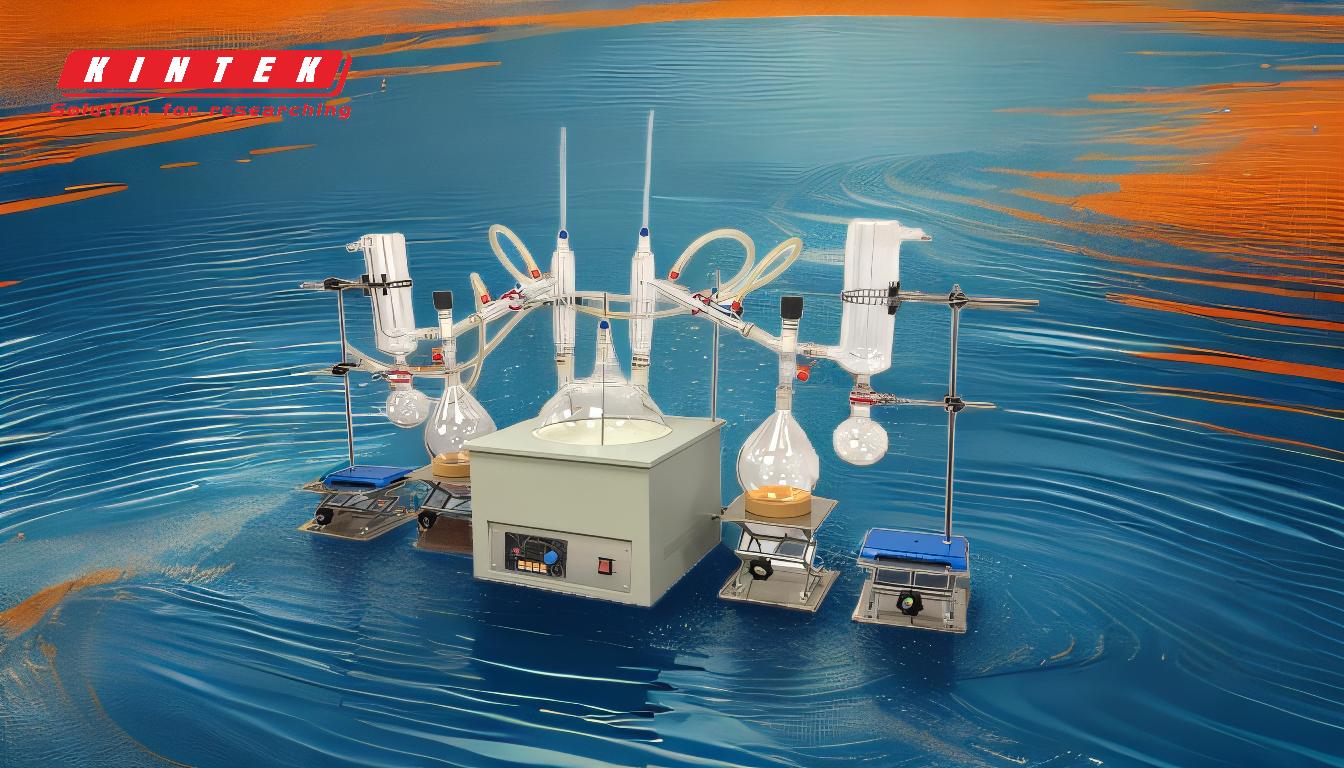Short path distillation is a specialized distillation technique used to separate compounds with high boiling points or those that are heat-sensitive. It operates under very low pressure (0.001 to 1 mbar) to reduce the boiling point of the target compounds, allowing them to evaporate at lower temperatures. The key principle is the short distance between the boiling surface and the condenser, which minimizes the exposure of the distillate to high temperatures and reduces product degradation. The boiling point difference in short path distillation is critical, as it determines the temperature at which the target compound vaporizes and condenses, ensuring effective separation from other components in the mixture.
Key Points Explained:

-
Principle of Short Path Distillation:
- Short path distillation operates under very low pressure (0.001 to 1 mbar), which significantly reduces the boiling points of the target compounds.
- The process involves creating a thin film of the solution on a heated surface, allowing the desired compound to evaporate at a lower temperature.
- The vaporized compound travels a short distance (a few centimeters) to the condenser, where it immediately re-condenses into a pure distillate.
- This technique is particularly useful for heat-sensitive and high-boiling-point materials, as it minimizes thermal degradation.
-
Boiling Point Difference in Short Path Distillation:
- The boiling point difference refers to the temperature gap between the boiling points of the target compound and other components in the mixture.
- In short path distillation, the boiling point of the target compound is lowered due to the reduced pressure, allowing it to vaporize at a temperature lower than its normal boiling point.
- The boiling point difference is crucial for effective separation, as it ensures that only the desired compound evaporates while other components remain in the mixture.
-
Role of Low Pressure in Reducing Boiling Points:
- The reduced pressure in short path distillation lowers the boiling point of the target compound, making it possible to evaporate and condense it at much lower temperatures.
- For example, a compound with a normal boiling point of 300°C might boil at 150°C under a pressure of 0.001 mbar.
- This is particularly beneficial for heat-sensitive compounds, as it prevents thermal decomposition that could occur at higher temperatures.
-
Importance of Short Distance Between Evaporator and Condenser:
- The short distance between the evaporator and condenser minimizes the time the vaporized compound is exposed to high temperatures, reducing the risk of thermal degradation.
- This is especially important for compounds that are unstable at high temperatures, such as organic compounds with high molecular weights.
- The short path also ensures that the distillate is collected quickly, minimizing product loss and improving the efficiency of the separation process.
-
Applications of Short Path Distillation:
- Short path distillation is widely used in the purification of heat-sensitive compounds, such as essential oils, cannabinoids, and other high-boiling-point organic compounds.
- It is also used in the pharmaceutical and chemical industries for the purification of compounds that are unstable at high temperatures.
- The technique is ideal for small-scale purification processes, where high purity and minimal product degradation are critical.
-
Advantages of Short Path Distillation:
- Low Temperature Operation: The reduced pressure allows for lower boiling temperatures, which is beneficial for heat-sensitive compounds.
- High Purity: The short distance and immediate condensation result in a high-purity distillate with minimal contamination.
- Minimal Product Degradation: The short exposure time to heat reduces the risk of thermal degradation, making it suitable for unstable compounds.
- Efficiency: The process is efficient, with minimal product loss due to the short travel distance of the vaporized compound.
-
Considerations for Equipment and Consumables:
- Vacuum System: A high-quality vacuum system is essential to maintain the low pressure required for the process.
- Heating System: The heating system must provide precise temperature control to ensure that the target compound evaporates at the correct temperature.
- Condenser: The condenser should be designed to quickly and efficiently condense the vaporized compound, ensuring minimal product loss.
- Material Compatibility: The materials used in the equipment must be compatible with the compounds being distilled, especially if they are corrosive or reactive.
In summary, the boiling point difference in short path distillation is a critical factor that determines the efficiency and effectiveness of the separation process. By operating under low pressure, the boiling point of the target compound is reduced, allowing it to be separated from other components at lower temperatures. This technique is particularly useful for heat-sensitive and high-boiling-point materials, ensuring high purity and minimal product degradation.
Summary Table:
| Key Aspect | Description |
|---|---|
| Principle | Operates under low pressure (0.001-1 mbar) to reduce boiling points, minimizing thermal degradation. |
| Boiling Point Difference | Critical for separating target compounds at lower temperatures. |
| Low Pressure Role | Lowers boiling points, enabling evaporation of heat-sensitive compounds without degradation. |
| Short Distance Importance | Minimizes heat exposure, ensuring quick condensation and high purity. |
| Applications | Used in essential oils, cannabinoids, pharmaceuticals, and chemical industries. |
| Advantages | Low-temperature operation, high purity, minimal degradation, and efficiency. |
| Equipment Considerations | Requires a high-quality vacuum system, precise heating, and compatible materials. |
Discover how short path distillation can optimize your purification process—contact us today for expert advice!









